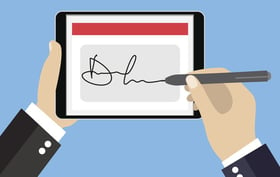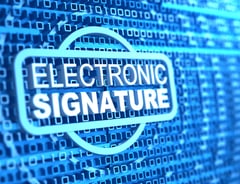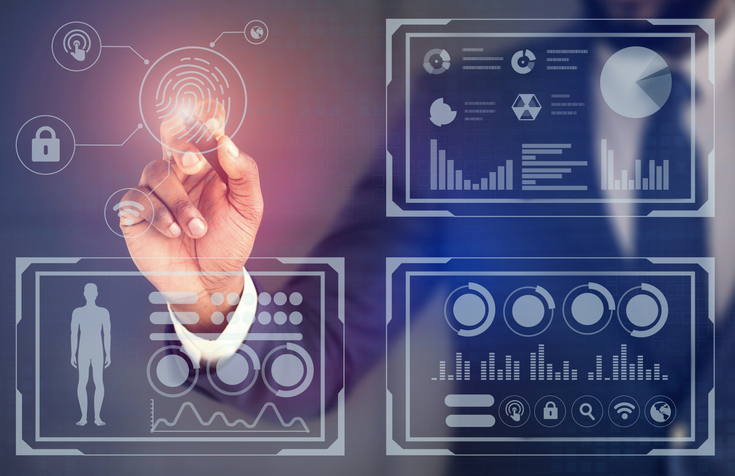Stay-at-home orders enacted to stem the spread of COVID-19, are being lifted. State and local governments are gradually allowing businesses that were termed non-essential to open. However, many employees will continue to work at home for an unspecified time. Customers and clients may want to interact remotely as well. Activities such as signing contracts and notarizing documents were once done exclusively in person. However, electronic signatures have been gaining acceptance in the US, since 2000 when the Electronic Signatures in Global and National Commerce Act (ESIGN Act) became a federal law. Because of our current circumstances, the use of electronic signatures is gaining even more traction.
 At DocuWare, we expect that electronic signature functionality will be an integral part of our customers’ operational, compliance and security initiatives. According to the law firm Pepper Hamilton LLP, “Despite the fact that most transactions today can be negotiated and closed electronically, signatures are an area that has been slow to adapt, and many parties still utilize “wet ink” original, physically signed signature pages and documents. This may be attributed to uncertainty regarding the legality of esignatures, a lack of understanding of legal requirements and how to utilize them, security concerns, or industry custom.”
At DocuWare, we expect that electronic signature functionality will be an integral part of our customers’ operational, compliance and security initiatives. According to the law firm Pepper Hamilton LLP, “Despite the fact that most transactions today can be negotiated and closed electronically, signatures are an area that has been slow to adapt, and many parties still utilize “wet ink” original, physically signed signature pages and documents. This may be attributed to uncertainty regarding the legality of esignatures, a lack of understanding of legal requirements and how to utilize them, security concerns, or industry custom.”
Get comfortable with the expanding role of esignatures
 DocuWare offers three types of electronic signatures through integration with Validated ID, a verified Trust Service Provider. The kind of electronic signature your organization chooses varies according to whether signers visit your location in-person; what type of device they will be using for access; and the level of security needed.
DocuWare offers three types of electronic signatures through integration with Validated ID, a verified Trust Service Provider. The kind of electronic signature your organization chooses varies according to whether signers visit your location in-person; what type of device they will be using for access; and the level of security needed.
Validated ID’s VIDsigner offers:
Remote (simple): For use anytime, anywhere. When a document is sent to Validated ID in a workflow, the employee responsible receives a message and releases the signature from a smartphone, for example, using an SMS code. To ensure security, a double validation is performed via e-mail and a one-time password (OTP) sent to the signer and enables them to confirm their identity.
Biometric (advanced): For face-to-face situations. Biometric signatures are handwritten electronically on tablets that can record the speed, angle and pressure applied by the signer. The biometrics are based on International Organization for Standardization (ISO) requirements.
ValidatedID’s VIDsigner encrypts biometric data and embeds it into the document, using a public key whose counterpart (private key) is stored in a notary’s office. In addition, to guarantee the integrity of the document, a timestamp and a one-time use digital certificate are used.
 Centralized (qualified): A digital certificate stored in the cloud. Used via any tablet, smartphone, or PC. With the centralization of keys and digital certificates, the complex generation of certificates is delegated to the service provider. The user simply authenticates through Validated ID to sign his or her pending documents. Users can access Validated ID from a smartphone app or a web page via their PC, laptop, or tablet. The centralized model supplies the highest level of security and the most options for accessing the system.
Centralized (qualified): A digital certificate stored in the cloud. Used via any tablet, smartphone, or PC. With the centralization of keys and digital certificates, the complex generation of certificates is delegated to the service provider. The user simply authenticates through Validated ID to sign his or her pending documents. Users can access Validated ID from a smartphone app or a web page via their PC, laptop, or tablet. The centralized model supplies the highest level of security and the most options for accessing the system.
The typed name under an email or a DocuWare stamp are examples of a simple signature. An advanced signature must be encrypted, with part of the key accessible only to the signer. In the case of a qualified signature, the identity of the signer is additionally verified with a certificate deposited with a trust service provider.
New challenges often spur the adoption of innovative technology. The wider adoption of electronic signatures was already making its mark. Responding to the new business environment with a digital format that reduces the need for in-person interaction, verifies the identity of the signer, and may be legally binding at the highest security level is a significant case in point.
Find out more about how electronic signatures can benefit your organization. Watch the webinar, Esignatures in an e-ver changing world.


